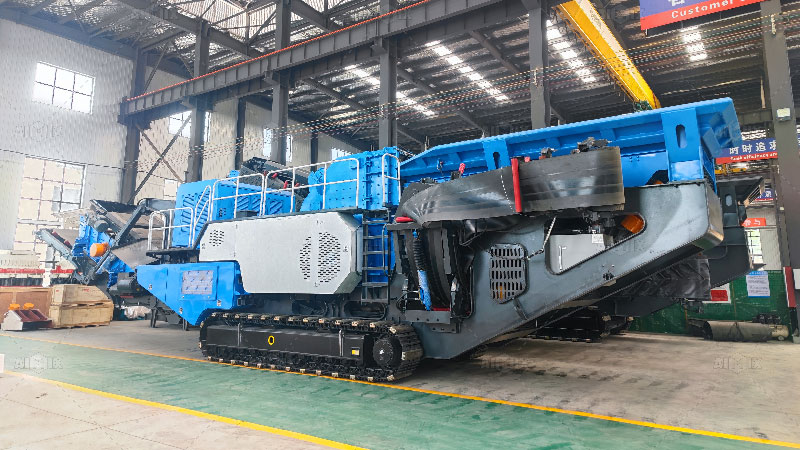The installation of a stone crusher plant is a crucial phase in any construction or mining operation. While the primary focus is on setting up a plant that can efficiently process materials, safety should always be a top priority. Proper safety measures during installation ensure the safety of workers and equipment and contribute to the long-term efficiency of the plant. Whether you are installing a mobile stone crusher plant or a crawler type stone crusher, adhering to the correct safety procedures is essential.
This article outlines key safety measures to follow when installing a mobile stone crusher plant(planta trituradora de piedra móvil) to minimize risks and ensure a smooth and safe operation.
1. Conduct a Thorough Site Assessment
Assessing Site Conditions
Before beginning the installation of a mobile or crawler type stone crusher, assess the site conditions to identify potential hazards. Ensure the ground is stable, and there is enough space for the crusher plant to operate without interference. Look for any risks such as uneven surfaces, exposed utilities, or nearby structures that could pose a danger to workers during installation or operation.
Identifying Environmental Hazards
Consider the environmental conditions of the area as well. Are there high winds, extreme temperatures, or other weather-related concerns that could impact safety? Identifying these hazards beforehand allows you to take preventive measures to protect workers and equipment.
2. Follow Proper Ground Preparation Techniques
Clearing the Site
Before installation begins, the site must be cleared of any debris, vegetation, or obstacles. This provides a safe and clean area for construction workers to operate and prevents any accidental damage to machinery. Large rocks, trees, and other obstructions should be removed to avoid complications when positioning the crusher plant.
Leveling and Compacting the Ground
Leveling the ground ensures that the equipment will sit on a stable foundation. Depending on the type of plant being installed, compacting the ground may also be necessary to ensure its stability. Uneven ground can cause misalignment of the crusher components, resulting in inefficiencies or equipment failure.
3. Ensure Proper Installation of Electrical and Mechanical Systems
Handling Electrical Components Safely
Stone crushers often require electrical systems to run motors, conveyors, and other machinery. Proper wiring, grounding, and safety measures must be in place to prevent electrical hazards during installation and operation. Ensure that all electrical components are installed by a qualified electrician and follow all local safety standards.
Securing Mechanical Components
Ensure that mechanical components such as belts, gears, and motors are properly aligned and securely fastened. Misaligned or loose components can result in malfunction or even accidents during operation. Regular checks during installation will help prevent these issues from developing.
4. Implement Proper Lifting and Handling Procedures
Using the Right Equipment for Lifting
Stone crusher plants are often heavy and require specialized equipment for safe lifting and positioning. Cranes, hoists, and other heavy-lifting machinery should be used to move large parts such as crushers, hoppers, and conveyors. Always use lifting devices that are rated for the load to prevent accidents.
Safety During Equipment Placement
Ensure that all personnel are clear of the lifting zone during the movement of equipment. Proper communication between the lifting team and ground crew is crucial to prevent accidents. Use signals and safety barriers to designate a safe area around the equipment being moved.
5. Provide Personal Protective Equipment (PPE)
Equip Workers with PPE
All workers involved in the installation of the stone crusher plant should wear appropriate personal protective equipment (PPE) to minimize the risk of injury. PPE should include hard hats, safety boots, gloves, eye protection, hearing protection, and reflective vests.
Ensuring Worker Safety
In addition to the standard PPE, workers should also have access to first aid kits, emergency contact numbers, and training in how to respond to accidents or injuries. Ensure that workers are familiar with safety procedures and are regularly trained on the latest safety protocols.
6. Safeguard Moving Parts and Machinery
Installing Safety Guards
A major hazard in any stone crusher plant is the moving parts, such as rotating blades, belts, and conveyors. Installing safety guards and covers around moving parts helps prevent workers from accidentally coming into contact with these dangerous components. Regularly inspect these guards to ensure they remain in place and are functioning correctly.
Lock-Out/Tag-Out (LOTO) Procedures
Implement lock-out/tag-out (LOTO) procedures to prevent equipment from starting up during maintenance or installation. This practice involves locking off power sources to machinery and clearly marking the equipment to prevent accidental operation while workers are working on it.
7. Follow Manufacturer Guidelines and Standards
Adhering to Installation Manuals
Always follow the manufacturer’s guidelines for installation, maintenance, and operation of the mobile or crawler type stone crusher(trituradora de piedra sobre orugas). The manufacturer’s manual will contain essential instructions for safely setting up and operating the plant. Failure to follow these guidelines can lead to equipment malfunction or dangerous situations on-site.
Compliance with Local Safety Regulations
In addition to manufacturer guidelines, ensure compliance with local safety standards and construction regulations. These regulations often cover issues such as site conditions, worker safety, and environmental impact, all of which contribute to a safe and efficient installation process.
8. Regular Inspections and Maintenance
Conduct Routine Inspections
Once the stone crusher plant is installed, schedule regular inspections to identify any potential safety issues. Check for wear and tear on moving parts, electrical components, and structural elements of the crusher. Address any issues immediately to prevent accidents or equipment failure.
Ongoing Maintenance
In addition to inspections, ongoing maintenance is essential for ensuring that the stone crusher plant continues to operate safely and efficiently. Maintenance schedules should be followed strictly, including lubricating moving parts, tightening bolts, and cleaning machinery to prevent blockages or malfunctions.
Conclusion
Installing a mobile stone crusher plant or a crawler type stone crusher requires careful planning and attention to safety. By assessing site conditions, following proper installation procedures, providing adequate training and PPE, and implementing safety measures around equipment, you can ensure a safe and successful installation process. Always prioritize safety to protect workers, extend the life of your equipment, and maintain smooth operations at your stone crusher plant.


Comments
No comments yet. Be the first to react!